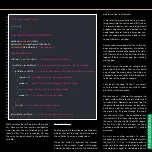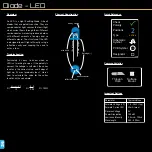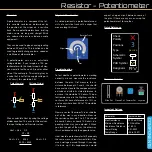
Resistor
Ohm’s Law
Ohms law is the most basic and useful
piece of maths used in electronics. We try
to keep things maths free, but this one is
unavoidable. It describes the relationship
between Resistance (R), Voltage (V), and
Current (I).
Ohm’s law states that the current through
a conductor between two points is directly
proportional to the voltage across the two
points. So, if the resistance stays the same,
then as voltage increases, current decreas-
es, and vise versa. If 2 of the three values
(V, I and R) are known, you can easily work
out the other using the following triangle.
Ohm’s law can be used to calculate volt-
age drops across components, the current
flowing through a circuit, the supply volt-
age, and the resistance across a compo-
nent (although some components like an
LED do not have a fixed resistance value).
This can be useful when diagnosing prob-
lems in circuits. If the current is too high,
maybe the resistance has dropped across
a component for example.
V
I
R
V
= I x R
V
I
R
V
I
R
=
V
I
R
I
=
V
R
Finding the voltage drop
across an LED:
(supply voltage = sum of
all voltage drops in a series
circuit)
Finding the value of a
current limiting resistor:
Finding the current draw in a
series circuit:
(the current that flows through
the resistor is the same as
the current that flows through
the LED
because they are in series)
LED
5V
0.02 Amps (2mA)
?V
V
1
115
Ω
LED
5V
0.02 Amps (2mA)
2.7V
?
Ω
5V
? Amps
LED
2.7V
115
Ω
V
1
= 0.02 x 115
V
1
= 2.3V
V
= 5 - 2.3
V
= 2.7V
R
= 5 - 2.7
0.02
R
= 115
I
= 5 - 2.7
115
I
= 115
40











































